
Sir William Hamo Thornycroft was an English sculptor, responsible for some of London's best-known statues, including the statue of Oliver Cromwell outside the Palace of Westminster. He was a keen student of classical sculpture and was one of the youngest artists to be elected to the Royal Academy, in 1882, the same year the bronze cast of Teucer was purchased for the British nation under the auspices of the Chantrey Bequest.

The Lady Lever Art Gallery is a museum founded and built by the industrialist and philanthropist William Lever, 1st Viscount Leverhulme and opened in 1922. The Lady Lever Art Gallery is set in the garden village of Port Sunlight, on the Wirral and one of the National Museums Liverpool.

Harry Bates was a British sculptor. He was elected to the Royal Academy in 1892 as A.R.A. and was an active, if intermittent, member of the Art Workers Guild. He was a central figure in the British movement known as New Sculpture.
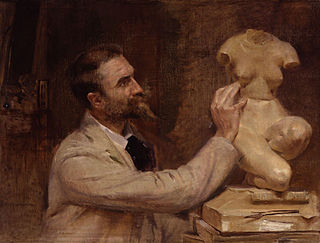
Edward Onslow Ford was an English sculptor. Much of Ford's early success came with portrait heads or busts. These were considered extremely refined, showing his subjects at their best and led to him receiving a number of commissions for public monuments and statues, both in Britain and overseas. Ford also produced a number of bronze statuettes of free-standing figures loosely drawn from mythology or of allegorical subjects. These 'ideal' figures became characteristic of the New Sculpture movement that developed in Britain from about 1880 and of which Ford was a leading exponent.
Events from the year 1877 in art.

Sir Alfred Gilbert was an English sculptor. He was born in London and studied sculpture under Joseph Boehm, Matthew Noble, Édouard Lantéri and Pierre-Jules Cavelier. His first work of importance was The Kiss of Victory, followed by the trilogy of Perseus Arming, Icarus and Comedy and Tragedy. His most creative years were from the late 1880s to the mid-1890s, when he produced several celebrated works such as a memorial for the Golden Jubilee of Queen Victoria and the Shaftesbury Memorial Fountain Eros on Piccadilly Circus.
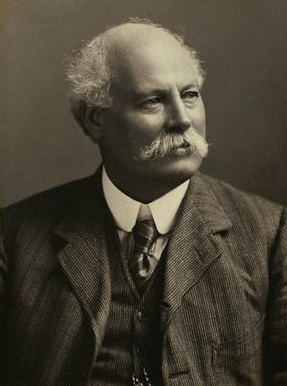
Sir Thomas Brock was an English sculptor and medallist, notable for the creation of several large public sculptures and monuments in Britain and abroad in the late nineteenth and early twentieth centuries. His most famous work is the Victoria Memorial in front of Buckingham Palace, London. Other commissions included the redesign of the effigy of Queen Victoria on British coinage, the massive bronze equestrian statue of Edward, the Black Prince, in City Square, Leeds and the completion of the statue of Prince Albert on the Albert Memorial.

John Henry Foley, often referred to as J. H. Foley, was an Irish sculptor, working in London. He is best known for his statues of Daniel O'Connell in Dublin, and of Prince Albert for the Albert Memorial in London and for a number of works in India.
The year 1892 in art involved some significant events.

Frederick William Pomeroy was a prolific British sculptor of architectural and monumental works. He became a leading sculptor in the New Sculpture movement, a group distinguished by a stylistic turn towards naturalism and for their works of architectural sculpture. Pomeroy had several significant public works in London and elsewhere in the United Kingdom, notably in Belfast. His work in London includes the figure of Lady Justice (1905–1906) on the dome of the Old Bailey.

Édouard Lantéri was a French-born British sculptor and medallist whose romantic French style of sculpting was seen as influential among exponents of New Sculpture. His name is also frequently spelled without accents as Edouard Lanteri and his first name sometimes given in its English form as Edward.
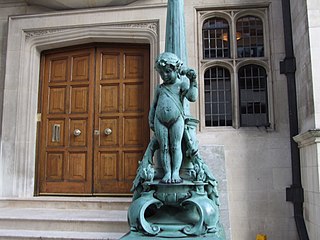
William Silver Frith (1850–1924) was a British sculptor.
Angelo Colarossi (1875–1949) was a studio boy and assistant to the sculptor Alfred Gilbert. At the age of 15, he modelled for Gilbert's most famous statue Anteros (1891) on the Shaftesbury Memorial Fountain in Piccadilly Circus. He was later employed by an English firm of aircraft manufacturers.
Edward Alfred Briscoe Drury was a British architectural sculptor and artist active in the New Sculpture movement. During a long career Drury created a great number of decorative figures such as busts and statuettes plus larger monuments, war memorials, statues of royalty and architectural pieces. During the opening years of the 20th-century he was among the foremost architectural sculptors active in Britain and in that period created the series of works in central London for which he is perhaps now best known. These include the figures on the Old War Office building in Whitehall, elements of the facade of the Victoria and Albert Museum and four of the colossal statues on Vauxhall Bridge.
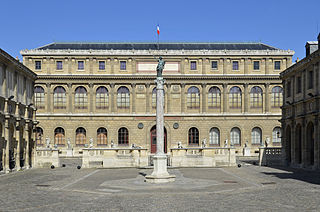
École des Beaux-Arts refers to a number of influential art schools in France. The term is associated with the Beaux-Arts style in architecture and city planning that thrived in France and other countries during the late nineteenth century and the first quarter of the twentieth century.

Andrea Carlo Lucchesi was an Anglo-Italian sculptor, born and trained in London, who had a career in the United Kingdom as an exponent of the naturalistic and symbolist "New Sculpture". His portrait of Queen Victoria is on the facade of the Art Gallery, at Bath. Lucchesi received his early training from his father, also a sculptor, and at the West London School of Art; he first exhibited at the Royal Academy in 1881. In 1882 his Waif won him acceptance at the Royal Academy schools, where he remained five years (1881–86). He was a member of the Art Workers Guild, established in 1884 to promote the "unity of the arts"
The International Society of Sculptors, Painters and Gravers was a union of professional artists that existed from 1898 to 1925, "To promote the study, practice, and knowledge of sculpture, painting, etching, lithographing, engraving, and kindred arts in England or elsewhere...". It came to be known simply as The International. The society organised exhibitions, some for members only and some open to others, and social events such as musical evenings and soirées. The exhibitions were held in a number of London venues, and in other cities around England, including Nottingham and Manchester. Its founder and first president was James McNeill Whistler. On his death, the presidency was taken up by Auguste Rodin, with John Lavery as vice-president. The society contributed £500 towards the cost of Whistler's memorial.
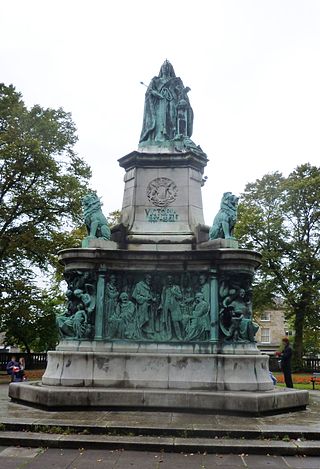
The Queen Victoria Memorial in Lancaster, Lancashire, England, is a Grade II* listed building. It stands in the centre of Dalton Square, Lancaster facing Lancaster Town Hall. It was erected in 1906, being commissioned and paid for by James Williamson, 1st Baron Ashton.
James Havard Thomas was a Bristol-born sculptor active in London and Capri. He became the first Chair of Sculpture at the Slade School of Art in London. He was known for his painstakingly precise sculptures resulting from elaborate and time-consuming processes for achieving sculptural realism. He emerged from the same roots as the "New Sculpture" in Britain, and his career runs parallel to that movement.
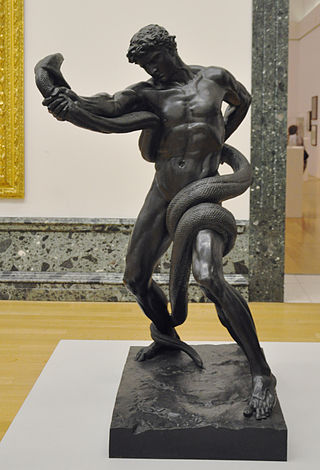
An Athlete Wrestling with a Python was the first of three bronze sculptures produced by the British artist Frederic Leighton. Completed in 1877, the sculpture was a departure for Leighton, and heralded the advent of a new movement, New Sculpture, taking realistic approach to classical models. It has been described as a "sculptural masterpiece" and as "possibly Leighton's greatest contribution to British art". Despite its indebtedness to the Classical tradition, it can be understood as one of the first stirrings of modern sculpture in Britain as well as in Europe. The Athlete was arguably the most influential piece of English sculpture of the 19th century.














